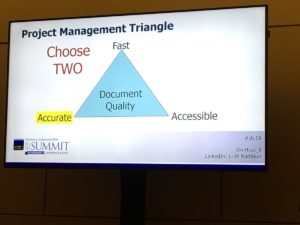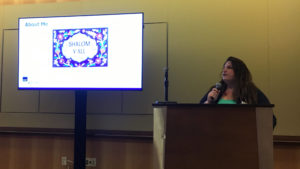By Viqui Dill, IDL SIG co-manager and proud member of the Technical Editing SIG
Watching Li-At Rathbun work a room is a joy. That’s why I knew that her presentation, “We Stoop to Conqquer: Adjusting to Mediocrity,” would be a must-see for me at the 2018 STC Summit. Once again, she did not disappoint.
Rathbun’s presentation was about technical editing. But the principles could be applied to any type of project management. Technical writers in every specialty have to make decisions about how to balance the sides of the scope/schedule/cost triangle. Excellence is often given a lower priority due to resource and schedule constraints. In this session, she addressed two important questions: “When our boss or client says ‘good enough’ work is good enough, shouldn’t it be good enough?” and “Why is it a struggle to produce mediocre work when that’s what the customer wants?”

https://twitter.com/viqui_dill/status/999297236256329733
Rathbun reinforced the project constraints triangle that managers often use to make choices between the competing demands for quality, scope, and cost. Creating a safe space for open discussion, Rathbun devised a “cone of silence” and even gave us our choice of male, female, or gender-nonspecific anonymous names. Let the healing begin.
Attendees began sharing their painful stories about projects for which they had to let go of quality for the sake of a deadline. We heard real stories from frustrated editors, writers, and managers. I can’t disclose specifics, of course, but I can reassure you that if you’ve ever been asked to hurry up and not be so picky, you’re not alone. Also, lots of SMEs think that good writing is easy. Hilarious.
Rathbun has the gift of engaging an audience and drawing them out. When writers or editors asked a difficult question, she turned to the managers in the crowd for an answer. She kept the conversation going and reassured attendees that the struggle is real. She also encouraged us to share our coping strategies, keeping the discussion upbeat.
I left the presentation feeling energized and affirmed. I am not alone in having to balance and let go. The room was full of fellow travelers who have to make hard choices. We accept mediocrity for the sake of cost and schedule. We live to write again on the next project.
My favorite take-away came from attendee Kathy Johnstone who advised that we keep three priorities in this order: get it done, get along, and get it right. Relationships and team morale are more important than perfectionism and will ensure that the next project goes smoothly. Sometimes we just have to let it go.
See the session details on CrowdCompass here
https://event.crowdcompass.com/stcsummit2018/activity/PPhBZgATpM

